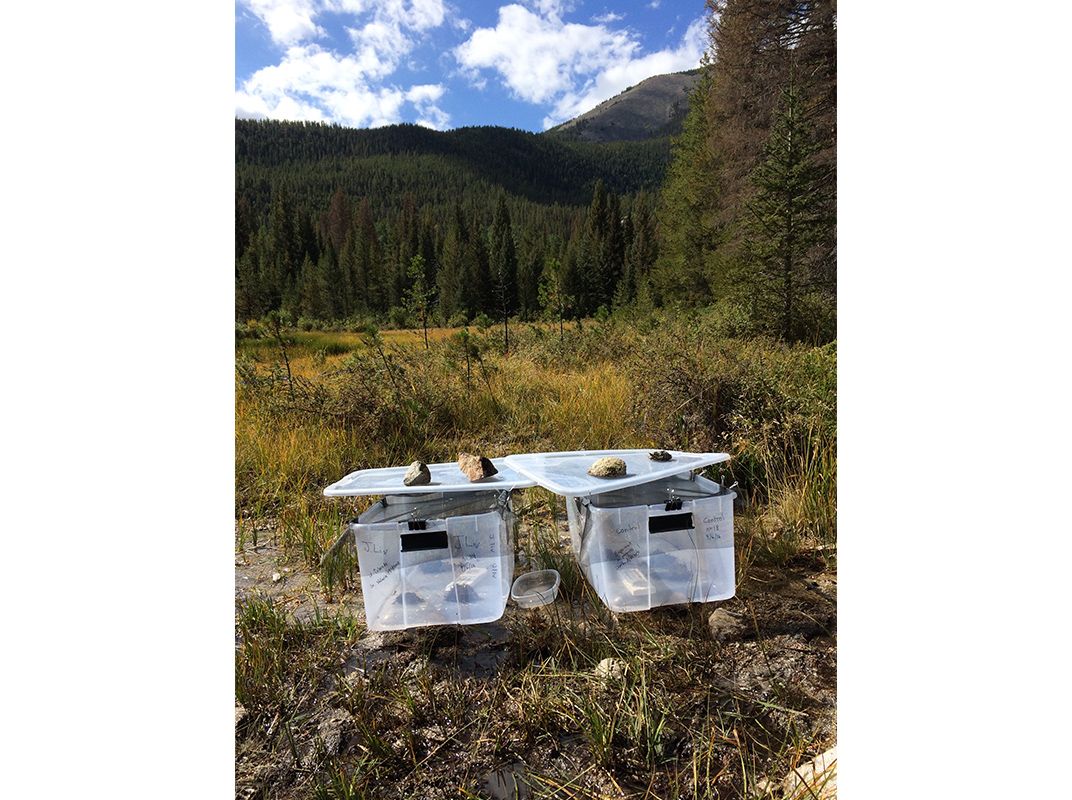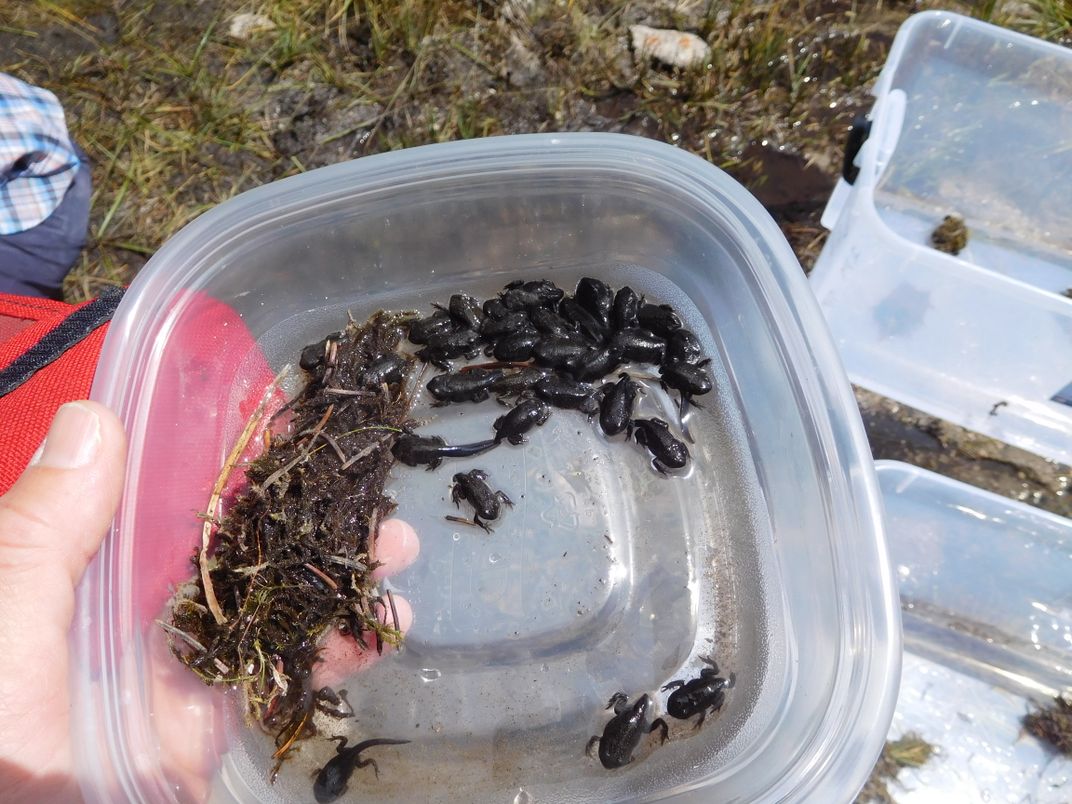Meet the Colorful New Weapon Scientists Are Using to Save Toads From a Devastating Fungus
Researchers are supplementing the amphibians’ natural microbiomes with a fluorescent fungus-fighter they’ve dubbed “Purple Rain”
/https://tf-cmsv2-smithsonianmag-media.s3.amazonaws.com/filer/25/7c/257c10a9-c63e-4f11-ad71-97b68a9c61ff/valswabbingtoad.jpg)
Valerie McKenzie's hotel guests could only be described as extraordinarily high-maintenance.
First off, they each require individual portable plastic units, which come free-of-charge with a jaw-dropping view of Colorado's Collegiate Peaks Mountains. During the first half of October, they were also treated to painstakingly-prepared, protein-packed daily meals, a two-week intensive probiotic bath treatment and a bi-weekly skin swab for microbiome analysis. Sadly, McKenzie's pampered charges weren’t able to express their appreciation for the royal treatment.
After all, the biologist at the University of Colorado, Boulder was running a “toad hotel.”
The fieldwork that McKenzie wrapped up in October has the potential to save billions of lives—amphibian lives, certainly, but possibly some human lives as well. She's hoping that the probiotic treatments she and her team administered to the toads in her hotels this fall could help give future toads a chance at fighting a deadly pathogen.
For decades, frog, toad and salamander populations worldwide have been ravaged by a mysterious fungal pathogen called Batrachochytrium dendrobatidis (Bd). That's a problem, because amphibians—40 percent of which are at risk of imminent extinction worldwide—are crucial to healthy ecosystems. Journalist Elizabeth Kolbert helped bring this ecological crisis to the public’s attention in an article for the New Yorker in 2009, and later in her Pulitzer Prize-winning book The Sixth Extinction.
It’s not just that these amphibians keep insect populations in check and serve as food for larger predators. They are also especially sensitive to their environments, making them “indicator species,” or animals whose health and population fluctuations can be used to gauge wider environmental disruption and damage. As if that weren't bad enough, biologists are also concerned by the fact that frogs, toads and salamanders play a role in regulating mosquito populations, which carry devastating diseases from West Nile to Zika.
And from a commercial standpoint, “we’re potentially losing pharmaceuticals,” says Reid Harris, a James Madison biologist and amphibian researcher. Harris is referring to the fact that frogs’ skin secretions might someday play in a role in treatments for key human diseases like HIV. “Losing even one species is unacceptable, but we’re looking at losing 42 percent of species,” Harris says. In some places, he adds, the environment is already reacting to extinctions in unforeseen ways. “In Panama there has been a massive extinction, and now you see a lot more algae growing in streams there,” he says.

McKenzie’s work builds on research Harris started nearly a decade ago. In 2008, his lab discovered that J. lividum, a bacteria naturally found on the skin of many toad and frog species, had useful fungus-fighting effects. It seemed to hold off the Bd long enough for frog immune systems to kick in and finish the job.
Harris first found himself drawn to J. lividum after watching it turn a deep purple color when in the lab, back when he was working with organic chemist Kevin P.C. Minbiole, now at Villanova University. “Any time a colony produced a color it got Kevin’s attention,” Harris says. He wanted to figure out the mechanism behind the color change.
As it turned out, the metabolite producing that hue change was key: While all the frogs he looked at had some J. lividum on them, only the ones who were bathed in a J. lividum solution were found to have the metabolite on them—and those were the ones that survived Bd exposure. All but one frog in the control group died.
In 2010, Harris was involved in a field trial with J. lividium that went further. After Reid cultured a strain of the bacteria native to California mountain yellow-legged frogs, biologist Vance Vredenburg of San Francisco State University applied the treatment using plastic containers. The frogs treated with the bacteria were the only ones that survived a year. But in year two, trout ate the entire population. (The trout had been dropped into the water for recreational fishing.) Vredenburg never published the results.
McKenzie’s toad hotels—a project her team dubbed “Purple Rain” in memory of Prince and in homage to the bacteria’s color—involved bathing 150 wild boreal toads in a J. lividum probiotic solution, too. She began by isolating a native strain of the bacteria and demonstrating that it had a protective effect. The native component was key: “We don’t want to take a microbe from another part of the world and introduce it,” she explains.
In a paper published this September, McKenzie, Harris and several other researchers demonstrated that treating captive boreal toads with J. lividum showed no adverse health effects, and increased their likelihood of surviving Bd exposure by 40 percent. The paper emphasized the importance of maintaining healthy microbiome diversity in captive animal populations across the board—especially because we do not yet understand the myriad health-related roles that these bacteria play.
McKenzie’s team initially planned to treat captive-bred toads and release them into the wild, but a cold snap killed off that cohort of toads. The state of Colorado asked McKenzie’s team to work with a wild population of metamorphosing toads instead. “They were feeling quite desperate,” says McKenzie. “In the Collegiate Peaks area, boreal toads were thriving and uninfected until several years ago, when state biologists started detecting Bd in those sites.” Boreal toads became endangered in Colorado in 1993.

McKenzie’s lab is still waiting to get back the data that will tell them if J. lividum stayed on the toads in her toad hotels. She's hoping the bacteria will have stuck for at least two weeks. “Toads can become infected as tadpoles, but the Bd tends to remain on their mouth parts,” says McKenzie. “It spreads during metamorphosis. And during metamorphosis the toads are hanging out in giant congregations, so if there is one infected individual, the infection can spread quickly.”
She adds that “if there’s an epidemic during metamorphosis, it wipes out 90 percent of individuals.” In those cases, the youngest adults die out before they ever lay eggs. Her team won’t get a sense of the survival rate within the treatment group because they didn’t mark the toads they experimented with for recapture (there were too few to make that a likely possibility). But if any toads survive in the spring it will be a huge success.
The next step would be to treat several hundred or even thousands of toads, says McKenzie, and to mark those for recapture to better determine how effective J. lividum treatments are at protecting toads.
While J. lividum treatments have shown promise for boreal toads and mountain yellow-legged frogs, they aren’t a magic bullet. For instance, they may not help all kinds of frogs, says Matt Becker, a frog researcher at the Smithsonian Conservation Biology Institute. Becker says he hasn’t seen success in treating captive Panamanian golden frogs with the bacteria. “The purple bacteria does not want to stick on their skin," he says.
There’s also the problem of rollout. “Each frog in its own Tupperware container, that’s not really going to work,” says Harris. Instead, he says scientists may someday transmit J. lividum or other probiotic treatments via water sources or by inoculating the treatment into the soil. “You can imagine scenarios where you augment the environment,” he says.
“When we get to populations where there are only a couple of strongholds left and we do targeted treatments, they may have a shot at persisting” or at least surviving a few more generations, says McKenzie. “That may give them a shot at continuing to evolve and adapt to the pathogen.” In other words, ultimately the goal isn’t to prop up amphibian populations indefinitely—but to buy them time.